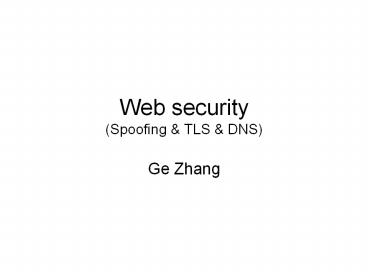Web security (Spoofing - PowerPoint PPT Presentation
Title:
Web security (Spoofing
Description:
Web security (Spoofing & TLS & DNS) Ge Zhang Web surfing URL spoofing Hyperlinks in malicious emails and web pages www.paypa1.com v.s. www.paypal.com What web is ... – PowerPoint PPT presentation
Number of Views:180
Avg rating:3.0/5.0
Title: Web security (Spoofing
1
Web security (Spoofing TLS DNS)
- Ge Zhang
2
Web surfing
3
Web security
- Does your request go to the right server?
- How do you trust the Internet?
4
URL spoofing
- Hyperlinks in malicious emails and web pages
- www.paypa1.com v.s. www.paypal.com
- What web is referred by this link?
http//www.kau.se_at_0x82EE0716/index.php - Dotless IP address
- http//130.238.7.22
- http//0x82EE0716/
- http//www.kau.se_at_0x82EE0716/
- http//www.kau.se_at_0x82EE0716/index.php
5
Have you ever noticed these?
6
X.509 certificate
- Based on public key cryptography and digital
signatures - CA certification authority
7
Verification
- Others can use the CAs public key to verify the
signature
8
Validating a Certificate
- Metaphor (1)
- CA Karlstad university
- Certificate owner the students (who get their
master degree) - Verifier employers
- Metaphor (2)
- CA1 Swedish Ministry of Education
- CA2 Karlstad University
9
Validating a Certificate
- Must recognize accepted CA in certificate chain
- One CA may issue certificate for another CA
- Must verify that certificate has not been revoked
- CA publishes Certificate Revocation List (CRL)
- Self-signed certificate?
10
Man-in-the-middle attacks (by malicious
intermediaries)
- Read the content of HTTP traffics
- Your password (even hashed?)
- Modify the content of HTTP traffics
- Transfer money from your account to the attacker.
11
Brief History of SSL/TLS
- SSLv2
- Released in 1995 with Netscape 1.1
- Key generation algorithm kept secret
- Reverse engineered broken by Wagner Goldberg
- SSLv3
- Fixed and improved, released in 1996
- Public design process
- TLS IETFs version the current standard
12
SSL/TLS Overview
- Establish a session (handshake layer)
- Agree on algorithms
- Share secrets
- Perform authentication
- Transfer application data (record layer)
- Ensure confidentiality and integrity
13
SSL Architecture
SSL Change Cipher Spec. Protocol
SSL Alert Protocol
SSL Handshake Protocol
HTTP, etc.
SSL Record Protocol
TCP
IP
- Record Protocol Message encryption/authentication
- Handshake P. Identity authentication key
exchange - Alert P. Error notification (cryptographic or
otherwise) - Change Cipher P. Activate the pending crypto
suite
14
SSL Handshake Protocol
- Two parties client and server
- Negotiate version of the protocol and the set of
cryptographic algorithms to be used - Interoperability between different
implementations of the protocol - Authenticate client and server (optional)
- Use digital certificates to learn each others
public keys and verify each others identity - Use public keys to establish a shared secret
15
Handshake Protocol (1)
- Client_hello version, random, session id, cipher
suite, compression method - Server_hello version, random, session id, cipher
suite, compression method
16
Handshake Protocol (2)
- Certificate X.509 certificate chain
- Server_key_exchange parameters, signature
- Certificate_request type, authorities
- Server_hello_done null
17
Handshake Protocol (3)
- Certificate X.509 certificate chain
- Client_key_exchange parameters, signature
- Certificate_verify signature
18
Handshake Protocol (4)
- Change_cipher_spec a single message, which
consists of a single byte with value 1. - Finished hash value
19
SSL Encryption
- Master secret
- Generated by both parties from premaster secret
and random values generated by both client and
server - Key material
- Generated from the master secret and shared
random values - Encryption keys
- Extracted from the key material
20
SSL Record Protocol
21
Alerts and Closure
- Alert the other side of exceptions
- Unexpected message
- Bad record mac
- Handshake failure
- Illegal parameter
- Bad certificate
- 2 levels
- Warning
- fatal
22
SSL Overhead
- 2-10 times slower than a TCP session
- Where do we lose time
- Handshake phase
- Calculating the key materials
- Data Transfer phase
- Symmetric key encryption
23
TLS/SSL Applications
- HTTP -gt HTTPS
- Telnet -gt SSH
- FTP -gt SFTP
- SIP -gt SIPS
- Resources http//www.openssl.org/related/apps.ht
ml
24
Homework
- Visit a web site with HTTPS
- Use wireshark to capture the traffics
- Read the parsed traffics, especially pay
attention on the handshake protocol.
25
The Domain Name System
- A database implemented by many name servers (NS)
- Distributed
- Replicated
- Hierarchical
26
Authoritative Servers
- Authoritative DNS servers
- An organizations DNS servers, providing
authoritative information for organizations
servers - Can be maintained by organization or service
provider
27
DNS Query and Response
Cache www.kau.se A 193.10.226.10
www.kau.se A?
Root DNS Server
www.kau.se A 193.10.226.10
local DNS Server
End-user
se DNS Server
www.kau.se A?
www.kau.se A 193.10.226.10
www.kau.se A 193.10.226.10
kau.se DNS Server
28
DNS Vulnerabilities
- No authentication.
- DNS_response.ID DNS_request.ID ? (16 bit
length) - DNS_response.dport DNS_request.dport?
- Significance DNS is widely used in
- Web
- VoIP
29
A Simple DNS Attack
Easy to observe UDP DNS query sent to well known
server on well known port.
www.seb.se A?
Root DNS Server
www.seb.se A 129.178.89.80
Users Laptop
local DNS Server
www.seb.se A attacker_IP
se DNS Server
Attackers Laptop
First response wins. Second response is silently
dropped on the floor.
seb.se DNS Server
30
A cache poisoning Attack
Cached a bad record www.seb.se A attacker_IP
www.seb.se A?
Users Laptop
www.seb.se A attacker_IP
local DNS Server
seb.se DNS Server
Attacker
31
A More Complex Attack
Response www.attacker.com A
128.9.128.127 attacker.com NS
ns.attacker.com attacker.com NS
www.seb.se ns.attacker.com A
128.9.128.2 www.seb.se A
128.9.128.127
kau Caching Server
www.seb.se 128.9.128.127
ns.attacker.com
Query www.attacker.com
Query www.seb.se
Any kau Computer
Remote attacker
32
Question
- Is SSL/TLS useful to counteract these DNS
attacks? Why? - Homewrok
- Read RFC 2535 about DNSSec
- http//www.faqs.org/rfcs/rfc2535.html
33
Key points
- URL spoofing dotless IP address
- X.509 certificate
- Certificate chains
- SSL/TLS
- Handshake protocol
- Alert protocol
- Record protocol
- Change cipher spec protocol
- The overhead caused by SSL/TLS
- DNS architecture
- DNS cache poisoning































